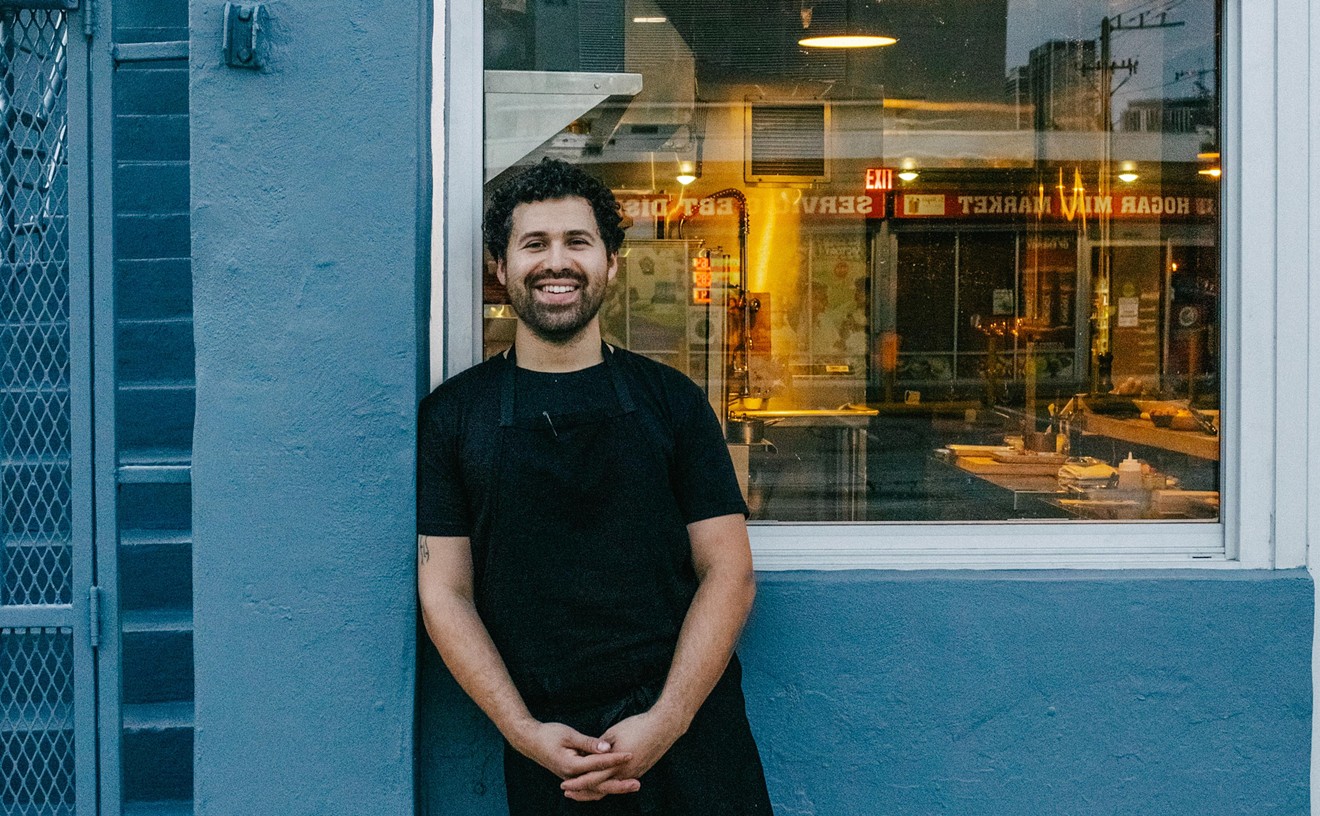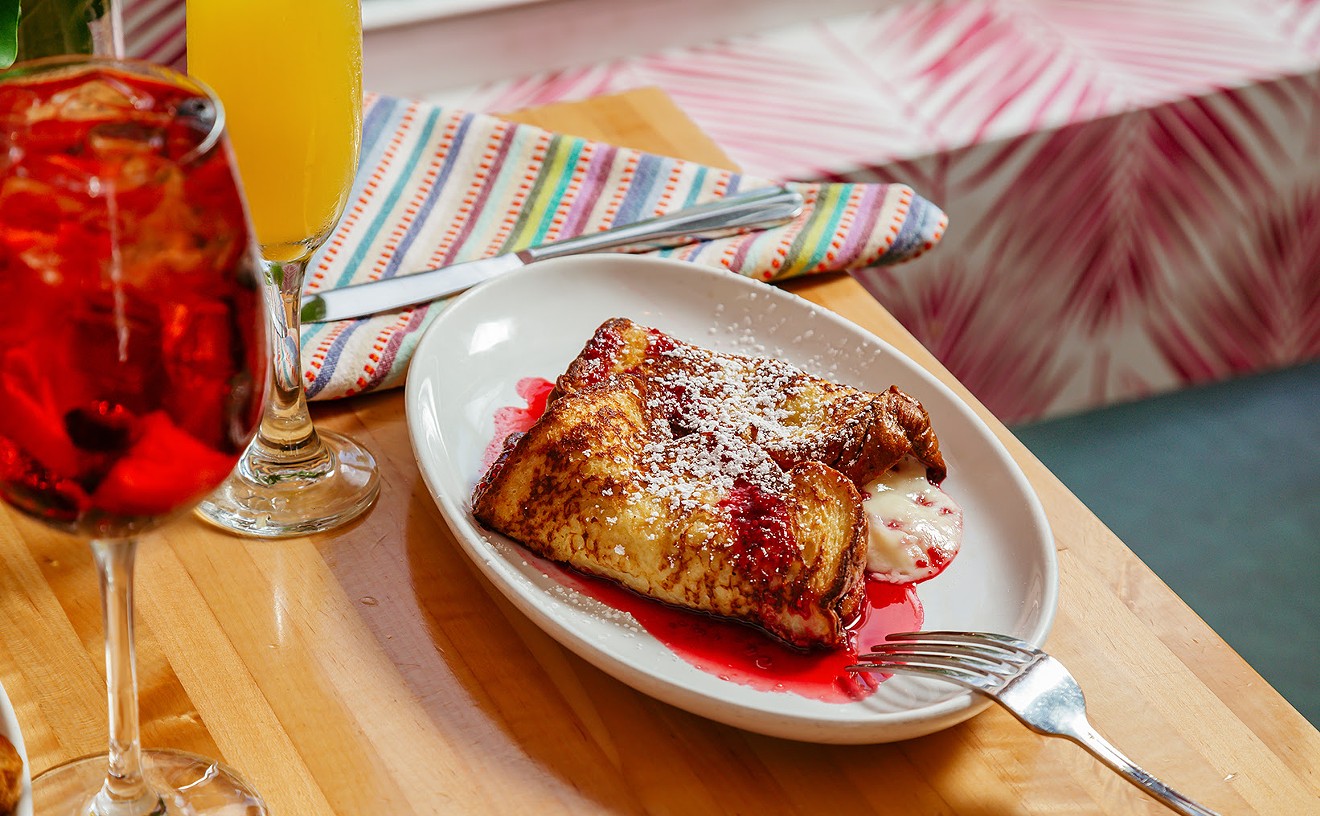Clad in white elegance and black lacquer floors, this two-level, 400-seater in the Gansevoort Hotel is as debonair as one might expect from a Chinese restaurant named Philippe. The space soars with supper-club sophistication. Central focal points include a lengthy bar, a black slate water wall, and a wall of glass that offers panoramic peeks (from either floor) into the big, bright, spotless kitchen — where gleaming steel woks hang above the stoves like an armored chorus line. If the timing is right, you might catch noodle-master Wai Ming Cheng working his magic. It is truly amazing to watch him, at a makeshift station in the middle of the dining room, as he stretches a ball of dough into an elastic strand, twirls it like a rodeo star performing a rope trick, and then quickly and unexpectedly — as though a sorcerer has summoned noodle spirits — hoists into the air a wooden bar curtained with perfect linguine-shaped strands. The wowed crowd breaks into applause.
Meanwhile, cooks galore are busy in the kitchen — the preponderance of hands not spoiling the broth but rapidly producing fresh and tasty fare that's not much different from your favorite neighborhood Chinese-American joint's menu. What distinguishes Philippe is price. It costs a considerable amount more than the norm for this particular cuisine.
When I visited, skewers of chicken satay started things off in promising fashion. Bright orange strips of meat, dyed in carrot juice, were lusciously enlivened via a sweetened, very buttery hot-Buffalo-wing-like crust. The look and texture of the satay sauce conjured cream of mushroom soup, but the peanut-coconut base, piqued with piquant peppers, provided its own sweet/spicy contrasts that were terrific in tandem with the chicken.
The satay set up expectations of more distinctive fare to follow. "Noodles with veal bean sauce" is certainly not something found in every Chinese restaurant — although the minced meat ragout does bear a resemblance to something found in every Italian restaurant: Bolognese sauce. Still, it was a delectable rendering atop firm rice noodles produced by Cheng. Dumpling doughs are dainty and delicious as well, whether plumped with pork and steamed, or filled with beef and pan-fried.
Though there are six types of dumplings, the only other nonfilled option is "flat noodles" — wide, white, made from rice, and tossed with the tenderest of chicken morsels, sprouts, onions, bell peppers, and a few stray snippets of scallion. Splendid stuff, it's very similar to a dish I've enjoyed at Lan Pan-Asian in Dadeland. It looks the same too — cleanly and simply presented on a white oval plate.
Philippe Chow, a Hong Kong native, studied with notable Chinese chefs, moved to America, and has worked for 25 years in the business, which included a stint as head honcho at a New York branch of the supertrendy Mr. Chow restaurant (no relation). Then the chef moved forward on his own and scored big with the first Philippe, in the city's Meatpacking District, where he attracted a Mr. Chow-like litter of glitterati. Let's hope you are impressed with Chow's accomplished resumé and his initial establishment's rollicking reputation, because you'll pay dearly for them.
At first glance, main course prices might provoke the sort of chest pain felt by long-distance runners in Beijing; dishes start at $42 (for chicken), and almost everything else is in the $50 to $60 range. Upon realizing that all numbers pertain to family-size servings for two (or three), there comes a sigh of relief (a mild sigh, similar to that experienced upon seeing gas prices drop to $4 a gallon). But what if you are dining as a couple, one in the mood for fish, the other for beef? No problem: The menu allows that "some dishes can be split," and our waiter further informed that all but three could be ordered this way.
Peking duck is indubitably for doubles, and this one is a dandy. One of the cooks comes from the kitchen to craftfully cleaver-carve the quacker tableside. Its crisply lacquered skin gives way to thin but succulent circles of meat. A more moderate half of "crispy duck" for one ($29) also gets portioned at the table, but by a waiter wielding two spoons; our bird ended up looking as if it had been pulsed in a blender. The meat was moist, though, and better when rolled in delicate house-made pancakes with hoisin sauce and a julienne of scallions and cucumbers.
Prawns, the most prolific menu protein, are prepared seven ways. We were leaning toward the version in "egg white sauce" until the waiter described it as "basically prawns over scrambled egg whites." So a last-second switch was made to "nine-season spicy prawns": six chubby, crunchily battered crustaceans in a translucent sweet-and-sour sauce that included red pepper flakes and a twang of vinegar. The classic "beef with oyster sauce" brought soft, flat strips of meat mingled with snap peas. The rust-colored stock-based sauce, with just a hint of the namesake ingredient, reflected refined French flavor but was sloppied by a gloppy cornstarch consistency. A tinny tureen of white rice was the only food served steaming-hot; everything else arrived on cold plates. It was surprising too that neither menu nor waiter offered brown rice as an alternative. Heck, even P.F. Chang's does that.
Actually, brown rice is listed as an á la carte side — just like fried rice with chicken, shrimp, or pork. The last was fresh and light, flecked with teeny bits of meat, sliced scallions, and a small amount of fried egg. The soy infusion was subtle, the flavor bland, and the temperature lukewarm.
Restaurant business surveys show tableside dessert presentations are a sure-fire means of increasing sales, but these are predicated on said pastries parading a visual appeal that seductively whispers, "Take me." Philippe's quintet, displayed on a three-tier cake stand, mumbles, "Take me or leave me." Least alluring of the lot was pear pound cake: four clumsily cut squares centering a scoop of vanilla ice cream. A cupcake-size red velvet cake, the most fetching of the few, came so thickly swathed in vanilla cream cheese — top, middle layer, and sides — that the tasty red velvet tones were reduced to singing backup. One can practically hear Elvis groan; Lord only knows what he'd say when told it costs $14 (plus tax and tip).
An army of workers roams the floor. Their attendance to diners is quiet, polite, and mostly professional — though sometimes not so much. On a busy weekend evening, we were often left in the lurch, and even on a calmer visit, the staff hadn't learned the art of numbering orders to know who gets what. We also noticed quite a few runners roaming around without a clue as to where food had been ordered. Still, owing to the sheer volume of employees ambling about, service is solid enough to more than satisfy. There are likewise few quibbles over the quality of nibbles. Unfortunately not as much can be said about the value.










